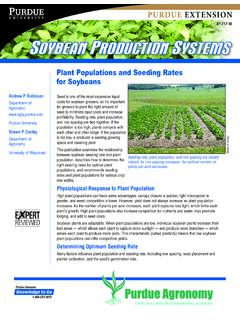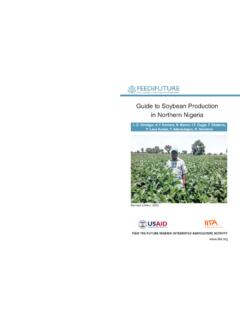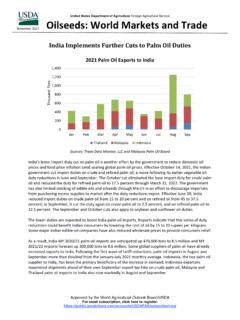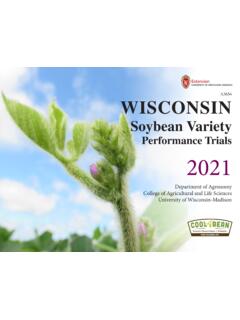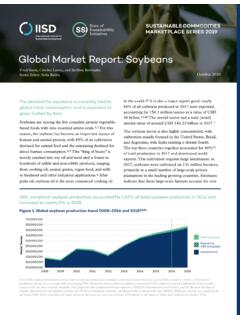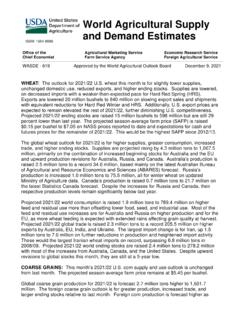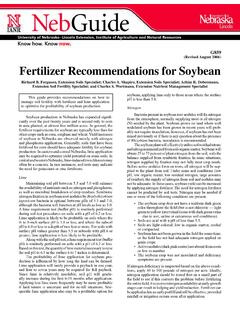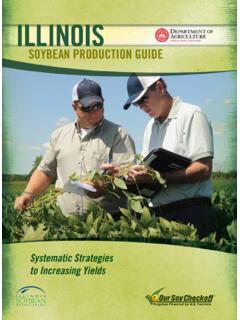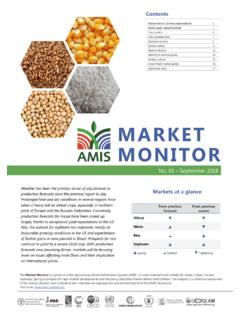Transcription of Cover Crop Spec Guide - Home | NRCS
1 planting Specification Guide Cover Crop November 2011 Page 1 of 8 Cover Crop planting Specification Guide NH-340 Selecting Cover Crops Select Cover crops, planting dates and seeding rates using either the Table1 (located on pg. 4 of the Cover crop standard) or Table 2b and Figure 1 at the end of this Guide . Ensure that crops are compatible with the cropping system and soils. Brief descriptions of the Cover crops can be found at the end of this Guide , and more detailed information can be found in the Managing Cover Crops Profitably publication or the Cornell Cover Crop Guide .
2 Figure 1 shows the Major Land Resource Areas (MLRA) for NH. MLRAs are geographically associated areas that share a common land use, elevation and topography, climate, water, soils, and vegetation. Figure 2 is the USDA Plant Hardiness Zones (PHZ) for NH and should be used to help determine when to plant within the defined seeding date range for a MLRA. If a farm is located in a colder/lower PHZ within a MLRA, consider planting the Cover crop earlier in the seeding date range. Germination % should be at > 80% or else the seeding rate should be increased to compensate. Consider using regional seed sources for improved reliability and performance. Establishing Cover Crops Cover crops may be established using a variety of methods, including broadcasting, interseeding, drilling, frost/dormant seeding, manure slurry seeding, and aerial seeding.
3 In general, seeding depth is related to seed size: larger seeds should be planted deeper. Care should be used to avoid planting small seeds too deep or large seeds too shallow. Seedbed preparation will depend on the species used, and the timing and method of planting . It is essential to provide good seed-soil contact Most Cover crops will not perform well if broadcast on a compacted or crusted surface. If seeding the Cover crop prior to harvest of the primary crop, no seedbed preparation is needed. Cover crops that are established with a grain drill are much more effective and economical than those established via broadcast. Frost and Dormant Seeding Frost seeding involves broadcasting appropriate species just after snowmelt in late winter/early spring. The freeze-thaw action of the soil works the seed into the soil.
4 Frost seeding should be done early in the morning when frost is still in the soil. Seed early enough allow for several freeze-thaw cycles. Dormant seeding involves broadcasting appropriate species in the early winter just after the field has frozen and the air temperature is low enough to prevent germination. Ideally this is just prior to snowfall. Seeds remain dormant under the snow through the winter and emerge in the spring. Both frost and dormant seeding are not completely reliable, but should be tried when a fall Cover cannot be established. Do not plow, cultivate, or operate heavy equipment on wet/thawed soils. Broadcasting on top of a lot of snow Cover is not recommended because the seed will tend to wash away. Fertility Cover crops usually follow heavily fertilized crops and do not require fertilization.
5 Fertilizer and lime recommendations are generally based on future cash crops. In some situations where a goal is to produce a lot of biomass and build organic matter with a crop like sorghum sudangrass, or produce a large root to reduce soil compaction with a crop like forage radish, additional nitrogen or manure may be necessary to achieve maximum growth. On soils with a high N leaching index or P index, consider planting Cover crops at least 1-2 weeks earlier to ensure excess nutrients are captured. planting Specification Guide Cover Crop November 2011 Page 2 of 8 Interseeding Interseeding in this Guide refers to the process of broadcasting a Cover crop into a cash crop.
6 Also known as undersowing or oversowing. Companion planting refers to the simultaneous planting of 2 or more crops. Large seeded crops, in particular, are planted or drilled along with the another crop ( corn and soybeans). Both crops tend to be harvested and have value, but one of the crops performs as a Cover crop ( soybeans provide N to corn) Nurse crops refer to rapidly growing crops that assist with the establishment of a perennial crop or other crop that is slow to establish. Mixes Common mixes for NH include a small grain like winter rye or oats with hairy vetch, red clover or peas. Other common mixes include annual ryegrass and clovers, timothy and alfalfa, and sorghum sudangrass or millets with soybean or cowpea. Trial unfamiliar combinations on a small-scale to determine if they will work.
7 When calculating a seeding rate for crops mixtures, ensure that the sum of the proportional rates used exceeds 100%. For example, if the full seeding rate for oats is 140 lbs/ac and hairy vetch is 35 lbs/ac, the combination of 80 lbs/ac oats (80/140=57%) and 20 lbs vetch (20/35=57%) would be acceptable because the 57%+57%=114%. A combination of 80 lbs/ac oats (57%) and 10 lbs/ac vetch (28%) would not be acceptable because 57%+28%=85%. Inoculants All legume seed shall be inoculated with a pure culture of nitrogen-fixing bacteria prepared specifically for the species. For best results, consider selecting pre-inoculated, coated seed when available. Cover Crops for Silage Corn Red clover and annual ryegrass can be interseeded into corn after last cultivation or sidedressing nitrogen when corn is 12-24 inches tall after June 1st.
8 Cool-season small grains can be aerial seeded into corn during late August-Early September. Use untreated seed when aerial seeding. Manure slurry seeding is an emerging technology that can be used in NH if there is access to equipment. Consider dormant seeding appropriate Cover crops like annual ryegrass and red clover to protect the soil in the spring. Grazing A number of Cover crops can be grazed prior to termination to improve the overall value of the Cover crop. Check each Cover crop to ensure that the crops pose no danger to livestock. A few examples are: (i) sorghum-sudangrass may cause prussic acid and nitrate poisoning if the young growth is grazed or if the crop is grazed after frost, (ii) seed of chickling vetch contain a neurotoxin that may cause illness, (iii) alsike clover may be toxic to horses and other livestock, (iv) turnips may cause copper toxicity in sheep, (v) red clover contains phytoestrogens that may complicate sheep breeding, and (vi) many of the legumes may cause bloat and should not be grazed when wet.
9 Living Mulches Vegetable crop producers should consider using living mulches to prevent erosion, improve soil structure and microbial population, improve water relations, and provide beneficial insect habitat. Legume living mulches like berseem clover are well suited for NH and provide supplemental N if they are mown and blown to adjacent cash crop rows. Living mulches can be established before or after the cash crop is planted, and can be used alone or in combination with plastic mulch. Using a biodegradable black plastic mulch and seed the alley with a living mulch is an management practice that is becoming popular in NH. Typically living mulches should be low growing and tolerate mowing. Mulches should be mowed if becoming overly competitive or if going to seed. Terminating Cover Crops In general, terminate Cover crops at least 1-2 weeks prior to planting the cash crop.
10 Small grain Cover crops should be at least 12-18 inches high. For organic, no-till systems Cover crops can be terminated on the same day as planting . Monitor crop maturity carefully to time termination. When terminating Cover crops by mowing or crimping, plants must often be in full flower or fully mature in order to completely kill. Avoid future weed problems by ensuring that Cover crops are terminated prior to seed set (unless a reseeding Cover is the goal). planting Specification Guide Cover Crop November 2011 Page 3 of 8 Cool-Season Annual Grains Winter Rye (Secale cereale) is the most reliable cool season Cover crop.










